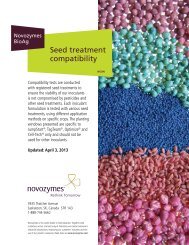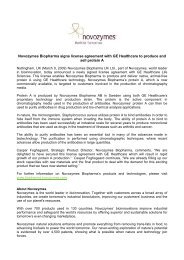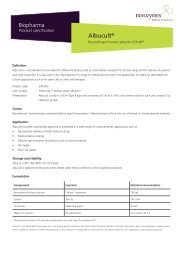Presentation - Novozymes
Presentation - Novozymes
Presentation - Novozymes
Create successful ePaper yourself
Turn your PDF publications into a flip-book with our unique Google optimized e-Paper software.
SUSTAINABILITY AS<br />
A BUSINESS DRIVER<br />
ODDO Environment Forum, Paris, June 20 2011
Safe Harbor Statement<br />
This presentation and its related<br />
comments contain forward-looking<br />
statements, including financial<br />
expectations.<br />
Forward-looking statements are by their<br />
very nature associated with risks and<br />
uncertainties that may cause actual<br />
results to differ materially from<br />
expectations.<br />
The uncertainties may include<br />
unexpected developments in the<br />
international currency exchange and<br />
securities markets, market-driven price<br />
decreases for <strong>Novozymes</strong>‟ products, and<br />
the introduction of competing products<br />
within <strong>Novozymes</strong>‟ core areas.<br />
2
Agenda<br />
Overview of <strong>Novozymes</strong><br />
<strong>Novozymes</strong> and sustainability<br />
Targets and performance<br />
Environmental management and business<br />
drivers<br />
Other sustainability issues<br />
3
<strong>Novozymes</strong> –<br />
The World Leader in Bioinnovation<br />
• Business consists of two segments:<br />
Enzyme Business and BioBusiness<br />
• 2010 sales: USD 1,75 billion<br />
Founded 1941<br />
Listed 2000<br />
• 2010 EBIT margin: ~ 22%<br />
• More than 700 products used in 130<br />
countries in over 30 different industries<br />
• + 6,500 granted and pending patents<br />
• + 5,500 employees<br />
• Two share classes; A and B shares<br />
• A share capital and 11% of B shares<br />
(25.5% of O/S; 70.1% of votes) held by<br />
Novo A/S, the management company of<br />
the Novo Nordisk Foundation<br />
Ticker<br />
Exchange<br />
Market Cap*<br />
Enzyme Business<br />
NZYM<br />
Copenhagen<br />
~ 10 billion USD<br />
BioBusiness<br />
Household<br />
Care<br />
Food &<br />
Beverages<br />
BioEnergy<br />
Feed &<br />
other Tech.<br />
Microorganisms<br />
Biopharmaceutical<br />
ingredients<br />
*A+B shares April, 2011<br />
4
Delivering Tomorrow‟s Solutions Today<br />
Delivering solutions from<br />
nature:<br />
food applications, detergents,<br />
pharmaceutical products, the<br />
energy sector and countless other<br />
applications<br />
Helping companies<br />
become more efficient:<br />
energy efficiency, saving raw<br />
materials, reducing waste and<br />
replacing chemicals<br />
This unique approach<br />
leads to:<br />
“more with less”<br />
higher quality, lower costs, better<br />
yields and a better environment<br />
5
Uniquely Diversified Group Creates Synergies and<br />
New Opportunities<br />
• Unique biotech-focused business with a strong legacy of delivering growth, earnings, and cash flow<br />
• ~ 14% of annual sales invested in R&D<br />
• Global provider of enzymes to all market segments creates global market leader position<br />
• Leveraging competencies across segments accelerates pace of innovation, reduces competition and creates<br />
high barriers to entry<br />
32% 30% 19%<br />
13% 4%<br />
2%<br />
Household<br />
Care<br />
Food &<br />
Beverages<br />
enzymes<br />
Bioenergy<br />
Feed & Other<br />
Technical<br />
Microorganisms<br />
Biopharmaceutical<br />
ingredients<br />
• Laundry &<br />
Dishwasher<br />
detergents<br />
• Baking<br />
• Brewing<br />
• Starch to<br />
syrups<br />
• Wine & juice<br />
• Corn ethanol<br />
• Cellulosic<br />
biofuels<br />
• Animal feed<br />
• Textile<br />
• Leather<br />
• Pulp & Paper<br />
• BioAgriculture<br />
• Wastewater<br />
• Institutional<br />
& household<br />
cleaning<br />
• Drug delivery &<br />
formulation<br />
• Medical devices<br />
• Bio-manufacturing<br />
Enzyme Business<br />
BioBusiness<br />
6
Undisputed Market Leader<br />
Expanding Enzyme Application<br />
2000 – Global enzyme<br />
market: DKK ~ 12bn<br />
2010 – Global enzyme<br />
market: DKK ~ 19bn<br />
Global enzyme market<br />
2010 value DKK ~ 19bn<br />
Rest of<br />
market<br />
57%<br />
<strong>Novozymes</strong><br />
43%<br />
Market potential*<br />
Rest of<br />
market<br />
53%<br />
<strong>Novozymes</strong><br />
47%<br />
Others<br />
16%<br />
DSM<br />
6%<br />
Captive<br />
10%<br />
<strong>Novozymes</strong><br />
47%<br />
Current enzyme market<br />
DKK ~ 19bn<br />
Danisco<br />
21%<br />
Untapped market<br />
Multi-billion (US$)<br />
Rules of competition<br />
dictated by innovation<br />
*Global markets for chemicals, food ingredients, feed additives, etc.<br />
7
Growth drivers<br />
Sustained growth<br />
and profitability<br />
Multiple Drivers Create a Sustainable<br />
Business with Significant Growth Potential<br />
• Innovation<br />
• Sustainability<br />
• Scarce raw material<br />
• Replacing chemicals<br />
• Energy efficiency<br />
• Cost/Performance<br />
• Waste reduction<br />
• Branding<br />
• Patient care<br />
1. Innovationdriven<br />
top-line<br />
growth<br />
2. Productivity<br />
improvements<br />
3. Leverage<br />
expertise<br />
outside enzymes<br />
Sustainable solutions<br />
8
1. Innovation-driven Top-Line Growth<br />
• Achieving growth through R&D investment remains a fundamental priority<br />
• > 50 product introductions in the last 5 years, ~ 100 active projects in current portfolio<br />
• R&D investment-reaping rewards with increasing diverse revenue streams<br />
R&D Expenditure 2005−2010<br />
(DKK million)<br />
20 year sales CAGR<br />
of around 8%<br />
Sales DKKm EBIT margin R&D/Sales ROIC<br />
880<br />
995<br />
1,096<br />
1,207<br />
1,360<br />
24%<br />
22%<br />
20%<br />
18%<br />
16%<br />
12.000<br />
10.000<br />
8.000<br />
6.000<br />
14%<br />
4.000<br />
12%<br />
2.000<br />
10%<br />
0<br />
2006 2007 2008 2009 2010<br />
9
2. Enzyme Technology Improves Profitability<br />
• Focused on improving margins through sophisticated technological solutions<br />
• Achieved sales CAGR of 8% over 20 years with improving margins<br />
• Roughly 20% of the R&D spend goes into productivity improvements<br />
Productivity improvements are gained in three ways:<br />
1. Production strain improvement<br />
2. Production process optimization<br />
3. Improving the enzyme produced<br />
FERMENTATION<br />
FORMULATION<br />
2. Optimizing the industrial production<br />
Traditional production optimization<br />
• Process optimization<br />
• Equipment optimization<br />
• Input optimization<br />
RAW MATERIALS<br />
PURIFICATION<br />
1. Improving the production strain<br />
MICRO-<br />
ORGANISMS<br />
Improving the microorganisms‟ ability to produce more<br />
enzymes per m 3 fermentation tank through genetic engineering<br />
ENZYMES<br />
3. Improving the enzyme produced<br />
Improving the efficacy of the<br />
enzymes through protein<br />
engineering. Customers buy efficacy,<br />
not volume<br />
10
3. Leveraging Expertise Generates<br />
Opportunities and Efficiencies<br />
Continued development in<br />
the following areas…<br />
…creates opportunities to apply technology in<br />
other areas<br />
Molecular<br />
biology<br />
Bio-informatics<br />
& Systems biology<br />
Strain development using<br />
protein engineering, genetic<br />
modification, DNA sequencing,<br />
etc.<br />
Application of computer<br />
algorithms in the<br />
computational discovery of<br />
enzymes in DNA databases<br />
Microorganisms<br />
Renewables<br />
Screening systems<br />
Application of high-throughput<br />
robotics to find the best<br />
enzyme candidates<br />
Pharma peptides<br />
Industrial-scale<br />
fermentation<br />
Production of enzymes and<br />
proteins whilst continuously<br />
optimizing and improving<br />
yields<br />
Polymers<br />
Underpinned by culture of knowledge-sharing across geographies and application fields<br />
11
Household<br />
Care<br />
Food & Beverage<br />
Bioenergy<br />
Feed & other<br />
Enzyme Business‟ Unique Industry Trends<br />
Industry Unique Trends Recent Launches<br />
Innovation<br />
Laundry Performance claims Chemical replacement<br />
Dishwasher<br />
Cold water wash<br />
Environmental regulation<br />
Compaction<br />
Chemicals replacement<br />
Lipoclean XPect<br />
Celluclean Mannaway<br />
Stainzyme Plus<br />
New<br />
functionalities<br />
Replacing<br />
chemicals<br />
Brewing<br />
Consolidation<br />
Alternative raw materials<br />
Volatile malt prices<br />
Efficiency<br />
Ondea Pro<br />
Attenuzyme<br />
Baking<br />
Starch<br />
Juice<br />
Fresh-keeping<br />
Market expansion<br />
High sugar prices<br />
Consolidation<br />
Consolidation<br />
Market expansion (E.M.)<br />
Efficiency<br />
Novamyl Pro<br />
Opticake Fresh<br />
Sucrozyme<br />
Saczyme<br />
Pectinex Ultra AFP<br />
Improved<br />
yields<br />
Enhanced<br />
quality<br />
Health & Nutrition<br />
Healthy foods<br />
Acrylaway<br />
Conventional<br />
biofuels<br />
Advanced<br />
biofuels<br />
Mature industry<br />
Emerging industry<br />
Huge global potential<br />
Marginal increases<br />
Needs ”birth help”<br />
Spirizyme Excel<br />
Cellic CTec2<br />
Improved<br />
yields<br />
Feed<br />
High phosphor prices Regulatory requirements<br />
Growing meat consumption High protein prices<br />
Ronozyme NP<br />
Ronozyme ProAct<br />
Textile<br />
Fragmented industry<br />
Environmental concerns<br />
Replacement of chemicals<br />
Low-cost industry<br />
FiberCare D<br />
Improved<br />
yields<br />
Forest<br />
High energy prices<br />
Replacement of chemicals<br />
Replacing chemicals<br />
12
BioBusiness – Q1 2011<br />
Exciting Projects with Potential of Delivering Growth<br />
Compound<br />
Indication<br />
Partner/<br />
Licenser<br />
Discovery<br />
Preclinical<br />
Phase I Phase II Phase III<br />
Market<br />
approval<br />
Type of future<br />
revenue stream<br />
End market<br />
potential<br />
NZ2114/<br />
plectasin<br />
(Gram Pos.)<br />
NZ17000/<br />
Arenicin<br />
(Gram Neg.)<br />
Hospitalacquired<br />
infections,<br />
e.g. skin,<br />
pneumonia,<br />
bloodstream<br />
and urinary<br />
tract<br />
Under<br />
starategic<br />
review:<br />
Looking at<br />
divestment or<br />
spin-off<br />
Not applicable<br />
Not applicable<br />
Not applicable<br />
Not applicable<br />
Albumin<br />
fusion<br />
Type 2<br />
diabetes<br />
(GLP1)<br />
GSK (HGS)<br />
Syncria<br />
License agreement:<br />
Royalties<br />
Blockbuster market<br />
potential<br />
Albumin<br />
fusion<br />
Neutropenia<br />
Teva (HGS)<br />
Neugranin<br />
License agreement:<br />
Royalties<br />
Blockbuster market<br />
potential<br />
Area/ Tech.<br />
Product<br />
Partner/<br />
Licenser<br />
2010 2011 2012 2013 2014 2015<br />
Type of future<br />
revenue stream<br />
End market<br />
potential<br />
Medical<br />
devices/<br />
Biopharma.<br />
Hyaluronic<br />
Acid<br />
None<br />
Product sales<br />
Bulk market ~ 9 tons in<br />
2008 ~ 1 BDKK, CAGR<br />
10-15% (Kline & Co.)<br />
Area/ Tech.<br />
Product /<br />
Field<br />
Partner/<br />
Licenser<br />
2010 2011 2012 2013 2014 2015<br />
Type of future<br />
revenue stream<br />
End market<br />
potential<br />
Agriculture<br />
Biopesticides<br />
& Biofertility<br />
None Product sales ~ 1 BUSD<br />
Renewable<br />
chemicals<br />
3HP for Bio<br />
Acrylic Acid<br />
Technology license<br />
Existing Bioacrylic Acid<br />
market ~ 11 BUSD,<br />
CAGR 4% (Nexant)<br />
Renewable<br />
chemicals<br />
Green<br />
polypropylene<br />
Technology license<br />
Existing polypropylene<br />
market ~ 66 BUSD,<br />
CAGR 4%(Nexant)<br />
Renewable<br />
Chemicals<br />
Intermediate<br />
chemical from<br />
ren. feedstock<br />
Technology license<br />
Not applicable<br />
13
Q1 2011 Summary<br />
Solid first quarter sales growth<br />
• Good demand across multiple industries<br />
and geographies<br />
• Positive currency impact in the quarter<br />
• Acquisition of EMD/Merck Crop BioScience<br />
impacted quarterly sales by ~ +5%<br />
Solid first quarter earnings growth<br />
• Productivity improvements<br />
• Better capacity utilization<br />
• Other operating costs grew less than sales<br />
• Negative impact from acquisition<br />
Expectations for full year 2011:<br />
• DKK sales growth expectation adjusted<br />
for USD depreciation<br />
• EBIT growth expectation maintained<br />
• Expectation for net profit and free cash flow before<br />
acquisitions increased<br />
World’s first commercial-scale cellulosic<br />
biofuel plant expected to open in 2012 in Italy<br />
Key financials Q1, 2011 Q1, 2010<br />
Total sales, DKKm 2,692 2,325<br />
Sales growth, DKK 16% -<br />
Sales growth, LCY 14% -<br />
Sales growth, organic 8% -<br />
EBIT, DKKm 635 535<br />
EBIT growth 19% -<br />
EBIT margin 23.6% 23.0%<br />
Net profit growth 21% -<br />
Free cash flow bef.<br />
acq., DKKm<br />
Net investments,<br />
excl. acq., DKKm<br />
477 270<br />
206 213<br />
ROIC incl. goodwill 22.8% 24.6%<br />
14
Performance Overview by Segment, Q1 2011<br />
Enzyme Business: DKK: +11%, LCY: +8%<br />
Household<br />
Care<br />
Enzymes<br />
Q111, DKK: +13%<br />
Q111, LCY: +11%<br />
• Increased penetration of enzymes across tiers<br />
• Emerging markets growth<br />
• Chemicals replacement<br />
Food &<br />
Beverages<br />
Enzymes<br />
Q111, DKK: +13%<br />
Q111, LCY: +11%<br />
• Broad appreciation across industries<br />
• Baking enzyme sales slightly lower<br />
• Starch enzyme sales driven higher by growth in emerging markets and high sugar<br />
prices<br />
• Customers’ focus on healthy concepts and quality drove demand<br />
Bioenergy<br />
Enzymes<br />
Q111, DKK: +8%<br />
Q111, LCY: +6%<br />
• Bioenergy enzyme sales growth in the US expected slightly lower compared to the<br />
preliminary Q1’11 US first-quarter ethanol output<br />
• Bioenergy enzyme sales outside the US slightly lower compared to Q1 2010<br />
• Expectations for the 2011 US ethanol production remain at 13.8 billion gallons,<br />
+5% compared to 2011<br />
Feed &<br />
Other<br />
Technical<br />
Enzymes<br />
Q111, DKK: +4%<br />
Q111, LCY: +1%<br />
• Feed enzyme sales saw stabilizing phytase enzyme sales and the growth track for<br />
Ronozyme ProAct continued<br />
• Textile & Leather enzyme sales lower due to challenging market conditions in Asia<br />
• Good development in other technical enzyme industries<br />
BioBusiness: DKK: +78%, LCY: +77%<br />
Microorganisms<br />
Q111, DKK: +95%<br />
Q111, LCY: +94%<br />
• Acquisition impact: ~ +85%<br />
• Acquisition of EMD/Merck Crop BioScience impacted sales growth in BioAg<br />
• Microorganisms for cleaning and wastewater solutions both delivered good growth<br />
Biopharma<br />
ingredients<br />
Q111, DKK: (7)%<br />
Q111, LCY: (10)%<br />
• Sales impacted negatively by timing effects<br />
15
Q1 2011 Financial Performance<br />
DKKm Q1, 2011 Q1, 2010<br />
Absolute<br />
Development<br />
Index<br />
Sales 2,692 2,325 367 116<br />
Gross profit 1,493 1,308 185 114<br />
Gross margin 55.5% 56.3%<br />
EBIT (Operating profit) 635 535 100 119<br />
EBIT margin 23.6% 23.0%<br />
Net profit 492 405 87 121<br />
EPS (diluted) 7.67 6.35 1.32 121<br />
Operating cash flow 683 483 200 141<br />
Net investments excl. acq. 206 213 (7) 97<br />
Free cash flow before acq. 477 270 207 177<br />
Acquisitions 1,550 - 1,550<br />
Free cash flow (1,073) 270 (1,343)<br />
Net interest-bearing debt 1,855 965 890<br />
Net debt-to-equity 23.9% 15.7%<br />
Equity ratio 59.1% 55.1%<br />
ROIC, incl. goodwill 22.8% 24.6%<br />
16
2011 Financial Outlook<br />
Guidance including<br />
the EMD acquisition<br />
Key financials 29.04.11 07.02.11 21.01.11 2010<br />
Sales, DKKm - - - 9,724<br />
Sales growth, DKK 8−11% 10−13% 7−10% 15%<br />
Sales growth, LCY 10−13% 10−13% 7−10% 10%<br />
Sales growth, organic 7−10% 7−10% 7−10% 11%<br />
EBIT, DKKm - - - 2,117<br />
EBIT growth 8−11% 8−11% 8−11% 25%<br />
EBIT margin ~ 22% 21−22% 21−22% 21.8%<br />
Net profit - - - 1,614<br />
Net profit growth 10−13% 8−11% 8−11% 35%<br />
Net investments, excl.<br />
acq., DKKm<br />
~ 1,400 ~ 1,400 ~ 1,400 1,326<br />
Free cash flow bef. acq.,<br />
DKKm<br />
1,000−<br />
1,100<br />
900−<br />
1,000<br />
900−<br />
1,000<br />
998<br />
ROIC ~ 21% ~ 20% 21−22% 22.2%<br />
17
M&G Breaks Ground for First Commercial Plant<br />
• <strong>Novozymes</strong>‟ partner M&G begins<br />
construction of the world‟s first<br />
commercial-scale cellulosic ethanol plant<br />
• The plant will produce 13 million gallons<br />
of ethanol per year from biomass, and is<br />
competitive with 60-70 USD/barrel<br />
oil<br />
• The biofuels plant will be ready in 2012,<br />
and is located in Crescentino, Northern<br />
Italy<br />
Pictures courtesy of M&G<br />
18
NOVOZYMES AND<br />
SUSTAINABILITY
Sustainability – <strong>Novozymes</strong>‟ ”DNA”<br />
Our statutes:<br />
“The company strives to do business in a<br />
sustainable and responsible way with regard to the<br />
economic, environmental and social aspects of our<br />
activities.”<br />
Our vision:<br />
”We imagine a future where our biological solutions<br />
create the necessary balance between better<br />
business, cleaner environment and better lives.”<br />
Our ambition:<br />
“To change the world together with our customers<br />
– drive the world towards sustainability through<br />
insights and solutions.”<br />
CHANGE THE WORLD<br />
20
<strong>Novozymes</strong>‟ Sustainability Journey<br />
Sustainability has been our business<br />
vision for a decade.<br />
Integration of sustainability in both our<br />
technology offering and business<br />
processes is our unique asset – it is the<br />
basis for all the benefits we offer our<br />
customers.<br />
Focused integration of our sustainability<br />
offerings into sales and marketing efforts.<br />
A clear sign of integration!<br />
Business dev.<br />
Cost reduction<br />
Risk minimization<br />
21
Fostering a Sustainability-driven Organization<br />
<strong>Novozymes</strong> in the Dow Jones Sustainability<br />
Indexes (DJSI):<br />
• Included in DJSI Biotechnology sector since<br />
2000, and sector leader 2000-2007, 2009 and<br />
2010<br />
• „Gold Class‟ rating in 2009 and 2010 by<br />
Sustainable Asset Management (SAM)<br />
Top 1% of Environmental Investment<br />
Organization carbon reporting<br />
Best in Class Storebrand SRI<br />
Member of Global 100 most sustainable<br />
corporations in the world<br />
Member of FTSE4Good Global and<br />
Europe<br />
Founding member of the Sustainability<br />
Consortium<br />
Member of SB20 by<br />
SustainableBusiness.com<br />
PRIME status by oekom research<br />
Member of OMX GES Sustainability<br />
Index<br />
22
<strong>Novozymes</strong>‟ Sustainability Organization<br />
Board of Directors<br />
Chair, Vice Chair, 8 members<br />
• Approve company ambition, strategy and targets<br />
• Overlook company performance, through, e.g.,<br />
quarterly reporting<br />
• Responsible for incentive programs<br />
Executive Management<br />
CEO, 5 EVPs<br />
• Define company ambition and set<br />
strategic direction<br />
• Approve SD strategy and targets<br />
• Overlook strategy execution<br />
Sustainability Development Board<br />
2 EVPs, 6 VPs<br />
• Identify and evaluate trends and issues<br />
• Draft SD strategy and targets<br />
• Execute SD strategy, via cross org. anchoring and integration<br />
with functional / business strategies<br />
23
Our Strategy is Based on Stakeholder Insights<br />
Retailers<br />
End<br />
consumers<br />
Customers<br />
Common<br />
long-term<br />
interest: Sustainable<br />
development<br />
NGOs<br />
Employees<br />
Public<br />
decision<br />
makers<br />
24
Sales & Marketing:<br />
Use of sustainability as co-business driver<br />
CUSTOMER<br />
DRIVERS<br />
• Prepare the customer for increased ”pull” from retailers<br />
• Prepare the customer for increased ”push” from regulators<br />
• Support the customer in achieving internal sustainability<br />
goals<br />
WHAT WE DO<br />
Help the customers differentiate themselves through the<br />
reduced environmental impact made possible by<br />
<strong>Novozymes</strong>‟ technology, LCA documented solutions as well<br />
as sustainability experience and insights<br />
VALUE FOR<br />
NOVOZYMES<br />
• We open doors at higher levels to showcase our technology<br />
• We build new business platforms due to the demand for low<br />
temperature detergents, replacement of chemicals<br />
• We create strategic partnerships, e.g. Walmart<br />
• A very careful guesstimate is that sustainability contributes<br />
to up to 25% of the growth for certain products<br />
25
Stakeholder Insights Lead to Concrete Initiatives<br />
R&D Purchasing Production<br />
Sales &<br />
Marketing<br />
People &<br />
Organization<br />
Positioning<br />
Finance, IT<br />
& Legal<br />
Supplier<br />
performance<br />
management<br />
program<br />
Use of sustainability<br />
as business driver<br />
backed up by LCAs<br />
Positioning of<br />
<strong>Novozymes</strong> as<br />
sustainabilitythought<br />
leader<br />
“LCA light”:<br />
Environmental<br />
profile of the<br />
product pipeline<br />
Ambitious<br />
targets<br />
for energy<br />
and water<br />
savings<br />
Sustainability<br />
bonus scheme<br />
+ targets for<br />
employee<br />
satisfaction and<br />
development<br />
Integrated<br />
sustainability<br />
reporting<br />
and investor<br />
road shows<br />
Cross-organizational initiatives<br />
Managing<br />
stakeholder<br />
relations<br />
Managing<br />
corporate<br />
governance<br />
Managing<br />
business<br />
integrity<br />
Managing<br />
labor and<br />
human rights<br />
Managing<br />
corporate<br />
citizenship<br />
Managing<br />
health and<br />
safety<br />
26
TARGETS AND<br />
PERFORMANCE
<strong>Novozymes</strong>‟ Ambition, Internal & External<br />
Reduce our<br />
CO 2 emissions<br />
to at least<br />
2007 levels<br />
Enable indirect<br />
CO 2 emission<br />
reductions of<br />
75 million tons<br />
by 2015<br />
Be a<br />
globally<br />
preferred<br />
employer<br />
ROIC of more<br />
than 22%<br />
Be recognized<br />
as a leader<br />
within<br />
sustainability<br />
Organic sales<br />
growth of more<br />
than 10% p.a.<br />
EBIT margin of<br />
more than 20%<br />
Enzymes for cellulosic bioethanol are not included in sales growth target<br />
28
Sustainability Targets and Achievements<br />
2010 achievements:<br />
Targets<br />
(index 2005)<br />
2009<br />
realized<br />
2010<br />
realized<br />
2011<br />
target<br />
2015<br />
target<br />
• Biotechnology sector leader in<br />
Dow Jones Sustainability Indexes<br />
and Gold class rating by SAM<br />
• Oekom PRIME status<br />
Water efficiency 28% 29% 31% 40%<br />
Energy<br />
efficiency<br />
27% 30% 32% 50%<br />
CO 2 efficiency 25% 38% 41% 50%<br />
• Founding member of the<br />
Sustainability Consortium<br />
Climate change<br />
Million tons CO 2<br />
emission<br />
reductions<br />
Occupational<br />
accidents<br />
Accidents per<br />
million working<br />
hours<br />
27 40 45 75<br />
5.1 4.1 4.5<br />
Rate of absence 2.3% 2.1% < 3%<br />
Employee<br />
turnover<br />
6.7% 7.5%<br />
> 4% –<br />
< 9%<br />
29
<strong>Novozymes</strong>‟ Historical Sustainability Performance<br />
Indicators 2010 2009 2008 2007 2006<br />
Water efficiency (index 2005) % 29 27 23 13 10<br />
Energy efficiency (index 2005) % 30 27 21 13 12<br />
CO 2 efficiency (index 2005) % 38 24 14 3 9<br />
Waste recycling % 43 45 45 43 42<br />
HCFC emission t 1.5 0.5 1.7 1.1 1.3<br />
Significant spills No 0 0 0 0 0<br />
Breaches of regulatory limits,<br />
groundwater<br />
No 28 27 22 21 22<br />
Breaches of regulatory limits, other No 36 17 19 17 8<br />
Fatalities No 0 0 0 0 0<br />
Frequency of occ. accidents per<br />
million working hours<br />
No 4.1 5.1 4.9 4.8 3.9<br />
Employees No 5,432 5,275 5,146 4,933 4,533<br />
Gender distribution (m/f) % 64/36 63.8/26.2 64.4/35.6 64.7/35.3 64.2/35.8<br />
Employee turnover % 7.5 7 11 9 8<br />
Absence % 2.1 2.3 2.2 2.2 2.3<br />
Animals for testing No 3,710 2,760 2,943 5,575 4,339<br />
30
Employee Data – Geographical Overview 2010<br />
Headcount<br />
Headcount<br />
Turnover<br />
Absence rate<br />
(Absolute)<br />
(% of total)<br />
(%)<br />
(%)<br />
Denmark 2,409 44.3% 4.7% 3.5%<br />
China 1,070 19.7% 5.7% 0.7%<br />
Americas 1,097 20.2% 9.9% 1.5%<br />
India 312 5.7% 21% 1.8%<br />
Rest of the world 544 10% 12.9% 1.3%<br />
Total/Average 5,432 100% 7.5% 2.1%<br />
31
Short and Long-term Sustainability Targets<br />
Sustainability targets for 2011:<br />
1. Enable a 45 million ton reduction in CO 2 emissions through our customers' application of our products<br />
2. Improve energy efficiency by 32% compared to 2005<br />
3. Improve CO 2 efficiency by 41% compared to 2005<br />
4. Improve water efficiency by 31% compared to 2005<br />
5. Score at least 75 for ”satisfaction and motivation” in our employee survey<br />
6. Score at least 70 for ”opportunities for professional and personal development” in our employee survey<br />
7. Keep the frequency of occupational accidents below 4.5 per million working hours<br />
8. Keep employee absence below 3%<br />
9. Keep employee turnover between 4% and 9%<br />
10.Retain our Gold Class rating by SAM in the Sustainability Yearbook<br />
Long-term sustainability targets:<br />
1. Enable a 75 million ton reduction in CO 2 emissions in 2015 through our customers' application of our<br />
products<br />
2. Improve energy efficiency by 50% in 2015 compared to 2005<br />
3. Improve CO 2 efficiency by 50% in 2015 compared to 2005<br />
4. Increase energy supply from renewable and CO 2 -neutral sources to 50% in 2020<br />
5. Improve water efficiency by 40% in 2015 compared to 2005<br />
6. Be recognized as a global leader in sustainability<br />
7. Be a preferred employer globally<br />
32
ENVIRONMENT
Environmental Management System and<br />
Performance<br />
The environment is important. That’s why:<br />
• All production sites are ISO 14001 certified<br />
• Our environmental reporting dates back to 1993<br />
• We use third party verification of our system and data<br />
Ambitious targets for our internal environmental savings result in…<br />
Water and<br />
energy<br />
efficiency<br />
An increase of water or energy efficiency by 1%<br />
corresponds to an annual reduction of purchased<br />
water and energy quantities by approximately<br />
1.5%, which corresponds to:<br />
80,000 m 3 water<br />
55,000 GJ energy<br />
Improved Water and<br />
Energy efficiency leads to<br />
lower resource<br />
consumption and a lower<br />
utility bill.<br />
Biomass<br />
Farmers' use of NovoGro and NovoGro30 as<br />
fertilizers eliminates the need for disposal at a<br />
waste treatment station (typically by incineration).<br />
In Denmark: 101,000 ton NovoGro30 (2010)<br />
In USA, China and Brazil: 377,000 ton<br />
(2010*)<br />
Farmers‟ use of biomass<br />
by-product eliminates the<br />
need, and related cost, for<br />
disposal<br />
(typically<br />
incineration).<br />
* A mix of NovoGro, NovoGro30, and compost. Cost savings not known.<br />
34
Decoupling Use of Resources from Economic Growth<br />
By 2050 we will be 9<br />
billion people!<br />
• Enzymes are efficient biological<br />
catalysts with microbial origin<br />
• Utilized in production processes<br />
they can increase efficiency,<br />
reduce energy consumption,<br />
lower raw material input or limit<br />
waste streams<br />
Economic Growth<br />
Resource Consumption<br />
Bioinnovation<br />
• With Bioinnovation we can<br />
produce ”more with less” and<br />
help decouple economic growth<br />
from the consumption of<br />
natural resources<br />
Time<br />
35
Sustainable Development is About Making the Right<br />
Choices – We Help our Customers to do so<br />
Life cycle assessment* enables<br />
us to compare environmental<br />
impacts of conventional and<br />
enzyme assisted processes<br />
Conventional<br />
Process 1<br />
method<br />
Enzyme assisted<br />
Process 2<br />
process<br />
In many cases small amounts<br />
of enzymes can replace large<br />
amounts of raw materials,<br />
chemicals energy, and water in<br />
industry<br />
User benefit<br />
... same benefit for the<br />
user - but different<br />
environmental impact<br />
*Life cycle assessment (LCA).<br />
36
LCAs Address Four Environmental Categories<br />
Global<br />
warming<br />
Acidification of the<br />
environment<br />
Nutrient<br />
enrichment<br />
Smog<br />
formation<br />
37
Reducing CO 2 Emissions<br />
together with our Customers<br />
• In 2010, <strong>Novozymes</strong> helped customers save 40 million tons of CO 2<br />
• <strong>Novozymes</strong> vision: Working towards a future where biological solutions create the necessary balance<br />
between a better business, a cleaner environment and better lives<br />
Net CO 2 saving using 1kg enzyme in different production processes<br />
3400 kg<br />
3800 kg<br />
30 kg<br />
40 kg<br />
100 kg<br />
150 kg<br />
150 kg<br />
200 kg<br />
Up to<br />
600 kg<br />
1300 kg<br />
BIOCATALYSIS<br />
CEREAL FOOD<br />
OILS & FATS<br />
PAPER<br />
ANIMAL FEED<br />
LEATHER<br />
TEXTILES<br />
BIOETHANOL<br />
DETERGENT<br />
FOOD<br />
38
Our Products Help Reduce CO 2 across Industries<br />
Detergent:<br />
100 kg CO 2<br />
per ton of laundry<br />
Animal feed:<br />
80 kg CO 2<br />
per ton of feed<br />
Textile:<br />
1100 kg CO 2<br />
per ton of fabric<br />
Cereals:<br />
110 kg CO 2<br />
per ton of bread<br />
Agriculture:<br />
15 kg CO 2<br />
per ton of corn<br />
Beverage:<br />
25 kg CO 2<br />
per 1000 litre of beer<br />
Paper making:<br />
150 kg CO 2<br />
per ton of pulp<br />
Leather:<br />
100 kg CO 2<br />
per ton of hide<br />
Vegetable oil:<br />
44 kg CO 2<br />
per ton of oil<br />
Dairy:<br />
230 kg CO 2<br />
per ton of mozzarella<br />
Corn ethanol:<br />
888 kg CO 2<br />
per 1000 litre of<br />
ethanol<br />
Cosmetics:<br />
190 kg CO 2<br />
per ton of fatty<br />
acid ester<br />
ILUC (Indirect land Use Change) is not considered.<br />
39
Potential CO 2 Savings Per Year in 2030<br />
• When using enzymatic solutions and current<br />
technology<br />
Million ton CO 2 saved in 2030<br />
• Industrial biotech can save the world up to<br />
2.5 billion tons of CO 2 per year<br />
• <strong>Novozymes</strong> is uniquely positioned to<br />
contribute to these savings<br />
633<br />
204<br />
1024<br />
668<br />
Provide substitutes for fossil fuels<br />
Substitute other chemicals<br />
Recycling waste into energy and materials<br />
Improve efficiency in industrial processes<br />
As estimated by WWF in September 2009<br />
40
Regular Bread vs. Enzymatically Processed Bread<br />
• If all bread sold in the United States contained<br />
extended shelf-life enzymes, bread would remain<br />
fresh for longer, meaning that less bread would be<br />
wasted and less wheat would need to be produced,<br />
with the result that there would be less use of<br />
fertilizers and less soil acidification.<br />
• In addition, the reduction in the transportation<br />
needed to distribute the bread would mean<br />
10% less CO 2 emissions due to fuller<br />
distribution trucks, fewer distribution points,<br />
and an overall increase in distribution<br />
efficiency.<br />
Savings potential in CO 2 per year:<br />
10%<br />
41
Novamyl has Transformed the Baking Supply Chain<br />
1.4g of Novamyl saves 10<br />
bread loaves…<br />
If Novamyl was used in all 6bn<br />
loaves consumed in the US:<br />
Global warming:<br />
300,000 ton CO 2<br />
…extends shelf-life by 10 days…<br />
Energy consumption:<br />
800,000 MWh<br />
Nutrient enrichment:<br />
2,000 ton PO 4<br />
… and saves transportation of 1 ton for 30km!<br />
Smog:<br />
540 ton ethylene eq.<br />
42
OTHER<br />
SUSTAINABILITY<br />
ISSUES
Managing Sustainability across the Value Chain<br />
R&D Purchasing Production<br />
Sales &<br />
Marketing<br />
People &<br />
Organization<br />
Positioning<br />
Finance, IT<br />
& Legal<br />
Supplier<br />
performance<br />
management<br />
program<br />
Use of sustainability<br />
as business driver<br />
backed up by LCAs<br />
Positioning of<br />
<strong>Novozymes</strong> as<br />
sustainabilitythought<br />
leader<br />
“LCA light”:<br />
Environmental<br />
profile of the<br />
product pipeline<br />
Ambitious<br />
targets<br />
for energy<br />
and water<br />
savings<br />
Sustainability<br />
bonus scheme<br />
+ targets for<br />
employee<br />
satisfaction and<br />
development<br />
Integrated<br />
sustainability<br />
reporting<br />
and investor<br />
road shows<br />
Cross-organizational initiatives<br />
Managing<br />
stakeholder<br />
relations<br />
Managing<br />
corporate<br />
governance<br />
Managing<br />
business<br />
integrity<br />
Managing<br />
labor and<br />
human rights<br />
Managing<br />
corporate<br />
citizenship<br />
Managing<br />
health and<br />
safety<br />
44
Contacts<br />
Martin Riise<br />
Investor Relations, Europe<br />
Rikke W. Nørgaard<br />
Sustainability Advisor<br />
Tobias C. Bjorklund<br />
Investor Relations, Europe<br />
Thomas Steenbech Bomhoff<br />
Investor Relations, US<br />
Tel.: +45 4446 0738<br />
Mobile: +45 3077 0738<br />
E-mail: mrsn@novozymes.com<br />
Tel: +45 4446 1853<br />
Mobile: +45 3077 1853<br />
E-mail: rwnq@novozymes.com<br />
Tel: +45 4446 8682<br />
Mobile: +45 3077 8682<br />
E-mail: tobb@novozymes.com<br />
Mobile (USA): +1 919 649 2565<br />
Mobile (DK):+45 3077 1226<br />
E-mail: tsbm@novozymes.com<br />
Further sustainability and investor relations information<br />
is available from the company homepage at<br />
www.novozymes.com<br />
45
OTHER<br />
SUSTAINABILITY<br />
ISSUES<br />
APPENDICES
Responsible Purchasing:<br />
<strong>Novozymes</strong>‟ Supplier Performance Management (1/2)<br />
• Instead of relying solely on supplier selfevaluations,<br />
the supplier evaluation process<br />
is supplemented with media research,<br />
dialogue, and the critical insight of<br />
<strong>Novozymes</strong>‟ purchasers.<br />
• A systematized but flexible approach to<br />
evaluating suppliers in <strong>Novozymes</strong> ( the<br />
riskier the supplier, the more thorough<br />
evaluation)<br />
• Advanced supplier evaluation and reporting<br />
system based on integrated performance<br />
criteria<br />
• In 2010, 90% of total purchase spend was<br />
covered by the program and significant<br />
suppliers have been screened.<br />
48
Supplier Criteria, Evaluation and Engagement (2/2)<br />
Supplier criteria:<br />
Evaluation process:<br />
Approved<br />
Conditionally<br />
approved<br />
Rejected<br />
No or only minor issues.<br />
Supplier is re-evaluated<br />
every 1-2 year<br />
Major issues but no<br />
alternatives. Keep eye on<br />
supplier and help supplier<br />
solve issue(s)<br />
Major issues. Supplier<br />
not approved<br />
Engagement:<br />
Action plans have been developed for<br />
noncompliant suppliers in order to<br />
improve performance. This has led to 168<br />
action plans (2010) with the majority<br />
resulting in dialogue with suppliers to<br />
resolve commercial, quality, and<br />
sustainability issues.<br />
49
Human Capital and Incentive Structures<br />
A lower employee turnover reduces recruiting and training related<br />
costs<br />
A lower absence rate corresponds to additional employees (for free)<br />
as well as reduces additional stress on colleagues who would<br />
otherwise have to work harder<br />
Incentive program:<br />
Incentive structures for employees and management (stock<br />
options, bonuses) depends on the fulfillment of short and long<br />
term targets according to the following key:<br />
• Short term sustainability targets: 25%<br />
• Short term financial targets: 25%<br />
• Long term targets: 50%<br />
50
Managing Corporate Governance<br />
Two-tier management system<br />
In accordance with Danish legislation, <strong>Novozymes</strong> has a two-tier management system<br />
comprising the Board of Directors and Executive Management, with no individual<br />
member of both<br />
Annual evaluation of competencies and collaboration<br />
Each year, the board of directors and the executive management conduct an evaluation<br />
of the working relationship to identify improvements<br />
The board of directors annually does an evaluation of whether or not it possesses the<br />
competencies needed to support, challenge and develop <strong>Novozymes</strong>‟ business and<br />
executive management<br />
Corporate governance code<br />
<strong>Novozymes</strong> follows the Danish Committee on Corporate Governance's recommendations<br />
through the "comply or explain"-principle. Reviewed annually, <strong>Novozymes</strong> currently<br />
follows 71 out of 78 recommendations and explains 7. All answers are available online<br />
at <strong>Novozymes</strong>.com<br />
51
<strong>Novozymes</strong>‟ Business Integrity Management System<br />
Business ethics and anticorruption<br />
• <strong>Novozymes</strong> business integrity principles<br />
• Management standard on business<br />
integrity<br />
• Committee on Business Integrity<br />
• External whistleblower mechanism<br />
• Training of employees<br />
• Principles covering suppliers<br />
• Systems/processes for seeking guidance,<br />
raising concern, reporting and review<br />
52
Managing Human Rights<br />
The entire organization annually develops self-assessments to document<br />
compliance and share best practices vis-à-vis our UN Global Compact based social<br />
minimum standards:<br />
• Respect Human Rights<br />
• Not complicit in Human Rights abuses<br />
• Freedom of Association<br />
• Non-discrimination<br />
• Disciplinary measures<br />
• Child labor<br />
• Forced labor<br />
Internal social audits follow up on self-assessments.<br />
53
<strong>Novozymes</strong> as a Corporate Citizen<br />
Corporate citizenship strategy<br />
As a responsible corporate citizen, <strong>Novozymes</strong> is committed<br />
to dedicating resources to forward looking community<br />
engagement activities. We offer communities to benefit from<br />
our skills and experience within science understanding and<br />
environmental responsibility (<strong>Novozymes</strong> does not give<br />
donations).<br />
<strong>Novozymes</strong> benefit from developing employee skills, risen<br />
employee satisfaction, new business opportunities and<br />
reaching out to future scientists (ensuring the talent pool).<br />
2010 spend:<br />
54
Managing Health and Safety<br />
OH&S focus areas:<br />
ZEAL – Zero Enzyme Allergy<br />
Stress and work-life balance<br />
The OH&S organization is based on two specialized units:<br />
Medical Centre<br />
•Headed up by a<br />
doctor<br />
•Medical focus<br />
•Advises individual<br />
employees on<br />
health problems<br />
Working<br />
Environment<br />
•Managing and<br />
coordinating<br />
OH&S and<br />
preventive work<br />
55
GMO and Microorganisms<br />
Enzymes – a part of all of us<br />
• Enzymes are substances found naturally in all<br />
living organisms, and produced for industrial<br />
use by microorganisms<br />
More than 25 years of safe production<br />
using GMO<br />
• Enzymes produced by genetically modified<br />
microorganisms in containment have a more<br />
than 25 years of safe use history in industrial<br />
production including food and feed production<br />
Key to solve some of global society’s<br />
challenges<br />
• The use of GM microorganisms is the<br />
prerequisite for development of smart and<br />
effective enzymes and other proteins which can<br />
contribute to solving some of the global<br />
society‟s challenges (ensuring enough food for<br />
the growing population, reducing emissions of<br />
greenhouse gases and adapting agricultural<br />
production to climate changes)<br />
What is gene technology<br />
“Gene technology” or “recombinant DNA<br />
techniques” are techniques with which<br />
Man can change the genetic composition<br />
of an organism through DNA manipulation<br />
outside the cell (in vitro).<br />
The use of gene technology enables the<br />
genetic transfer of desired characteristics<br />
(improved traits) among organisms<br />
resulting in genetically modified organisms<br />
(GMOs).<br />
56
NOVOZYMES AND<br />
TECHNOLOGY<br />
APPENDICES
What are Enzymes<br />
• Enzymes can be found in all living organisms:<br />
human beings, animals, plants, microorganisms<br />
• Enzymes are proteins catalyzing<br />
biological processes<br />
• Proteins are substances, not organisms<br />
• All proteins are composed by a string of amino<br />
acids, each placed in 20 possible positions<br />
arranged in different orders<br />
• The sequences of the amino acids determine<br />
the structure and thus the function and<br />
properties of the enzymes (e.g., the catalytic<br />
activity, the specificity and stability)<br />
58
What are Microorganisms <br />
• Microorganisms are living organisms<br />
(bacteria, fungi ..)<br />
• All organisms have genes which are based on<br />
DNA, and which determine the characteristics<br />
of the organism<br />
• All living organisms can reproduce themselves<br />
• Microorganisms are very suitable for enzyme<br />
production<br />
59
<strong>Novozymes</strong>‟ use of Gene Technology<br />
• Development of new GM microorganisms that can produce enzymes and other proteins,<br />
including biopharmaceutical ingredients<br />
• As host organisms, mainly Aspergillus oryzae and Bacillus licheniformis are used<br />
• All <strong>Novozymes</strong>‟ GM microorganisms are used in containment. <strong>Novozymes</strong> does not produce<br />
GM microorganisms for deliberate release into the environment<br />
60
Genetically Modified Microorganisms<br />
• Genetically modified microorganisms (GMMs)<br />
is a subgroup of GMOs (genetically modified<br />
organisms)<br />
• A classical GMM is constructed by taking a<br />
gene from one microroganism and inserting it<br />
into another (also called heteorologous<br />
cloning)<br />
• A self-cloned GMM is constructed by taking<br />
multiple copies of a gene and reinserting it<br />
into the organism from which it was originally<br />
taken (also called homologous cloning)<br />
61
GM Microorganisms<br />
Examples:<br />
• Tailor-made genetically modified<br />
bacteria and fungi (Aspergillus oryzae<br />
and Bacillus licheniformis ) used as cell<br />
factories in containment<br />
Modified to optimize production of:<br />
• Additives (citric acid, aspartame)<br />
• Enzymes<br />
• Vitamins (Vitamin B2, C)<br />
• Amino acids (animal feed)<br />
• Chemicals, pharmaceuticals<br />
62
Safety and Quality Come First<br />
• <strong>Novozymes</strong>‟ policies state the commitment to quality and safety<br />
• Products are subject to extensive toxicological characterization during development<br />
• Final products are subject to a thorough risk assessment covering application and handling<br />
• Production plants are authorized and inspected by national authorities<br />
• <strong>Novozymes</strong> has an integrated quality management system that controls development,<br />
production, distribution and supporting processes<br />
• Food and Feed safety is ensured by procedures that control raw materials, production hygiene<br />
and traceability (food and feed GMP)<br />
<strong>Novozymes</strong>‟ commitment to quality and safety is documented by a long track-record and a<br />
number of certifications, e.g.<br />
• ISO 9001: 2008 (quality)<br />
• ISO 14001: 2004 (environment)<br />
• FAMI-QS (feed producing plants)<br />
• ISO 22000, FSSC 22000 (Danish plants, food safety)<br />
• AIB (American Institute of Baking) (Danish and US plant, food safety)<br />
• Numerous audits by customers<br />
63
<strong>Novozymes</strong>‟ Use of Industrial Biotechnology<br />
Carefully using the technology.<br />
<strong>Novozymes</strong> uses industrial white biotechnology and contained use of gene technology. Contact<br />
with the outside environment is restricted and controlled when using genetically modified<br />
microorganisms (GMMs). Gene technology makes the production process efficient and helps<br />
reducing environmental impact without being part of <strong>Novozymes</strong>‟ final product!<br />
Joining efforts with NGOs<br />
<strong>Novozymes</strong> has made efforts to demystify gene technology together with Danish society for<br />
Nature Conservation (DN). Together with WWF, we have documented the potential of<br />
biotechnology to save CO 2 .<br />
All GMMs used at<br />
<strong>Novozymes</strong> are<br />
categorized to<br />
Safety Level 1 (EU<br />
Directive<br />
98/81/EC)<br />
64


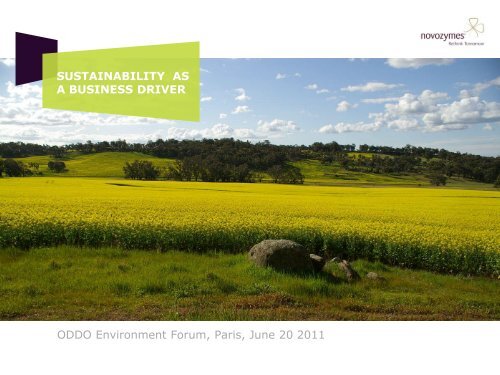

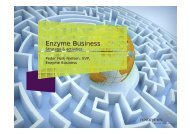


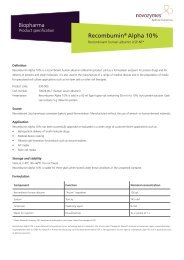
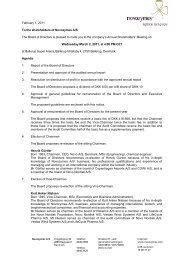

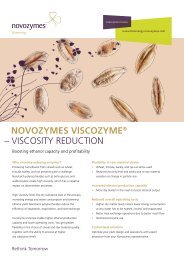
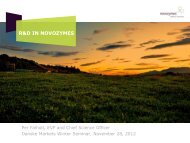
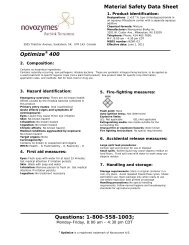

![Novozymes Cellic[®] CTec3 - Secure your plant's lowest total cost](https://img.yumpu.com/50573332/1/184x260/novozymes-cellicar-ctec3-secure-your-plants-lowest-total-cost.jpg?quality=85)
